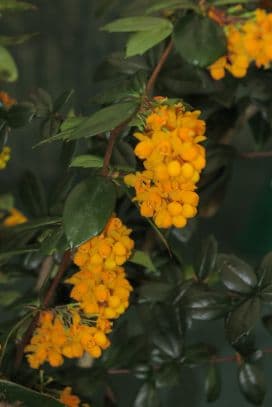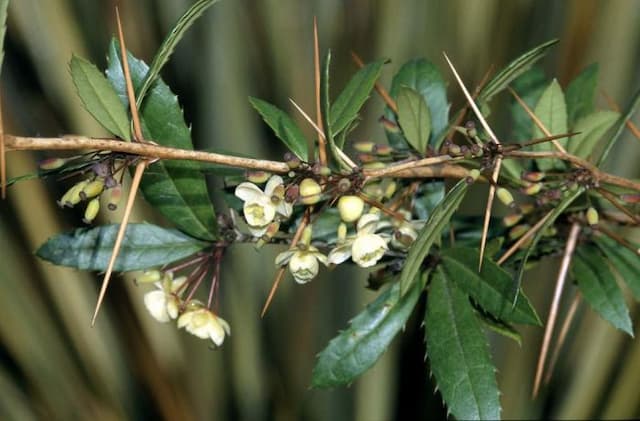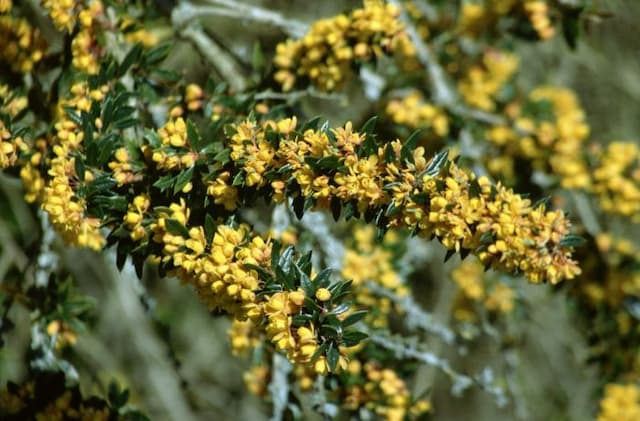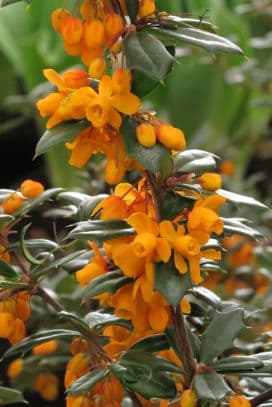Horned Goat Weed Epimedium 'Spine Tingler'

ABOUT
Epimedium 'Spine Tingler' is a distinctive ornamental plant, particularly admired for its unique foliage and attractive flowers. The leaves of this variety exhibit a lance-shaped form with spiny, toothed edges that are suggestive of its name. The foliage presents a vivid green hue that can add a lushness to any plant composition. As seasons transition from spring to fall, the leaves may undergo a transformative color shift, displaying a range of hues that accent the garden with tones of red or bronze. The plant's leaves also provide a stunning backdrop to its flowers which are held aloft on wiry stems, creating an enchanting, floating effect. The blossoms of the 'Spine Tingler' come in an array of delicate, cup-shaped flowers, typically in soft shades of yellow. These blooms might carry a subtle, alluring fragrance that can make them even more appealing in a garden setting. Suspended above the foliage, the flowers form an eye-catching display that can attract pollinators such as bees and butterflies. Overall, the 'Spine Tingler' is appreciated for its ornamental value, providing visual interest through its intricate leaf shapes, seasonal color changes, and charming flowers that together create a textured and nuanced appearance.
About this plant
 Names
NamesFamily
Berberidaceae
Synonyms
Spine Tingler Fairy Wings, Spiny-leaf Epimedium
Common names
Epimedium 'Spine Tingler'.
 Toxicity
ToxicityTo humans
Epimedium 'Spine Tingler', commonly known as horny goat weed, is not typically regarded as toxic to humans when consumed in moderate amounts. Traditional herbal medicine uses it for various purposes, and it's usually considered safe. However, large doses or long-term use might have side effects such as dizziness, vomiting, dry mouth, and nosebleed. In some cases, it could interact with certain medications and could affect heart function and hormone levels.
To pets
The horny goat weed is not commonly listed as a toxic plant to pets such as dogs and cats. However, as with most plants, there is always the potential for individual animals to have a reaction or for side effects to occur if they ingest a large quantity. Common symptoms, if any, would likely be gastrointestinal in nature such as vomiting or diarrhea. If you suspect your pet has ingested a large amount of the plant, it is always best to consult with a veterinarian.
 Characteristics
CharacteristicsLife cycle
Perennials
Foliage type
Evergreen
Color of leaves
Green
Flower color
Yellow
Height
1 foot 2 inches (35 cm)
Spread
1 foot 18 inches (50 cm)
Plant type
Herb
Hardiness zones
5
Native area
China
Benefits
 General Benefits
General Benefits- Aesthetic Appeal: Epimedium 'Spine Tingler', also known as horny goat weed, adds visual interest to gardens with its unique foliage and delicate flowers.
- Shade Tolerance: It thrives in partial to full shade, which makes it ideal for underplanting in wooded areas or shaded borders.
- Drought Resistance: Once established, this plant is tolerant of dry conditions, requiring less frequent watering.
- Ground Cover: Its spreading habit can help to cover bare spots in the landscape, reducing erosion and suppressing weeds.
- Four-Season Interest: It features evergreen leaves, early spring flowers, vibrant fall color, and interesting leaf shapes, providing year-round garden interest.
- Low Maintenance: It requires minimal care beyond the occasional trim to maintain shape or to remove any winter-damaged foliage.
- Deer and Rabbit Resistant: This plant is not a preferred food source for deer and rabbits, which helps to protect it from browsing animals.
 Medical Properties
Medical PropertiesThis plant is not used for medical purposes.
 Air-purifying Qualities
Air-purifying QualitiesThis plant is not specifically known for air purifying qualities.
 Other Uses
Other Uses- Leaf printing: The unique leaf shape of Epimedium 'Spine Tingler' can be used for leaf printing activities in art projects or for creating natural patterns on fabric or paper.
- Floral arrangements: The delicate flowers can be used in fresh or dried floral arrangements for their unusual structure and lively color.
- Garden border accents: The contrasting foliage can serve as a striking edge for garden borders or paths, providing a textured groundcover.
- Thematic gardens: This plant is excellent for fantasy-themed gardens due to its whimsical appearance that suggests a fairyland aesthetic.
- Photography subject: Amateur and professional photographers alike may utilize Spine Tingler as a photogenic subject due to its intricate details and vibrant colors.
- Fairy gardens: The small stature of Spine Tingler makes it suitable for inclusion in miniature fairy gardens, adding a touch of magic and enchantment.
- Educational tool: Gardeners and educators can use the plant to teach about plant adaptations, such as the epimedium's ability to thrive in shade.
- Leaf mulch: Fallen leaves from the Epimedium 'Spine Tingler' can be used to create a nutrient-rich leaf mulch for garden beds.
- Living mulch: When planted densely, the ground-hugging nature of Spine Tingler can act as a living mulch, reducing weed growth and conserving soil moisture.
- Creative inspiration: Artists and writers can draw inspiration from the plant’s unique form and storybook charm for their creative works.
Interesting Facts
 Feng Shui
Feng ShuiThe plant Epimedium, commonly known as Horny Goat Weed, is not traditionally used in Feng Shui practice.
 Zodiac Sign Compitability
Zodiac Sign CompitabilityThe plant Horny Goat Weed is not used in astrology practice.
 Plant Symbolism
Plant Symbolism- Endurance: Epimediums, also known as barrenwort, are beloved for their resilience and ability to thrive in difficult conditions, symbolizing the capacity to endure challenges.
- Lustful attraction: Given the tongue-in-cheek nickname 'horny goat weed', barrenwort carries a symbolic meaning of sensual desire and aphrodisiac qualities.
- Protection: Barrenwort is often considered a protective plant in gardens, symbolizing safety and a shielding quality against negative influences.
- Adaptation: Due to its versatility in different environments, barrenwort symbolizes the ability to adapt and flourish in various situations.
 Water
WaterThe Bishop's Hat should be watered deeply once a week, with 1 to 2 gallons of water per plant, ensuring that the soil is moist but not waterlogged. During the hot summer months or in particularly dry conditions, you might need to increase the frequency to twice a week. Conversely, in cooler or rainy periods, reduce watering to prevent root rot. It's important to water the soil directly and avoid wetting the foliage to reduce the risk of fungal diseases. Always check the top inch of soil for dryness before watering to ensure the plant needs additional moisture.
 Light
LightBishop's Hat thrives in partial shade, preferring a spot that is shielded from intense afternoon sun. Morning light with dappled or filtered sunlight throughout the day is ideal. Too much direct sunlight can scorch the leaves, while too much shade can lead to sparse flowering. An ideal spot would be under the canopy of lightly spaced trees or on the north or east side of structures, where the light is consistent but not too harsh.
 Temperature
TemperatureBishop's Hat tolerates a wide range of temperatures, but it grows best within the 50°F to 75°F range. Ensure that temperatures do not fall below 20°F, as extreme cold may damage the plant. Similarly, sustained temperatures above 80°F may stress the plant. Mulching can help moderate soil temperature and protect the roots from extreme conditions.
 Pruning
PruningPrune Bishop's Hat in late winter or early spring before new growth starts. Cut back old foliage to ground level to encourage fresh, new growth and improve air circulation. Pruning once a year is typically enough, and the best time for this is when you can clearly see the old stems without the interference of new growth. Removing spent flowers after blooming can sometimes encourage a second, though less profuse, flush of flowers.
 Cleaning
CleaningAs needed
 Soil
SoilBishop's Hat (Epimedium 'Spine Tingler') prefers a soil mix that is rich in organic matter, well-draining, and maintains moisture without being waterlogged. An ideal mix would be one part garden soil, one part compost, and one part perlite or pine bark fines. Aim for a slightly acidic to neutral pH of 6.0 to 7.0.
 Repotting
RepottingBishop's Hat should be repotted every two to three years or when it outgrows its current container. This helps refresh the soil and provide room for new root growth. It's best to repot in spring before the growing season begins.
 Humidity & Misting
Humidity & MistingBishop's Hat thrives at average to high humidity levels, ideally ranging from 40% to 70%. It can tolerate lower humidity, but consistent moisture levels will support its lush foliage growth.
 Suitable locations
Suitable locationsIndoor
Place in bright, indirect light and ensure high humidity.
Outdoor
Plant in part shade, shelter from afternoon sun.
Hardiness zone
5-9 USDA
 Life cycle
Life cycleThe life of the Epimedium 'Spine Tingler', commonly known as Spine Tingler Fairy Wings, begins with seed germination, typically in spring when soil temperatures increase and adequate moisture is present. Upon germination, the plant develops a small rosette of leaves and establishes a rudimentary root system. As the growing season progresses, the plant matures and forms its distinctive spiny-toothed, heart-shaped leaves and begins to spread through rhizomes, slowly forming a clump. By late spring to early summer, Spine Tingler Fairy Wings produces airy sprays of small, star-shaped yellow flowers above its foliage, an important stage for pollination and reproduction. After flowering, seeds develop and are dispersed, while the foliage often remains attractive through the summer and into the fall, sometimes changing color with the season. In winter, the plant goes dormant, with its foliage dying back, and it survives the cold season as underground rhizomes before the cycle begins anew the following spring.
 Propogation
PropogationPropogation time
Spring to summer
The Epimedium 'Spine Tingler', often referred to as Fairy Wings or Bishop's Hat, is best propagated by division, a task most successfully undertaken in the spring just before new growth begins. To propagate by division, carefully dig up an established clump of the plant, making sure to keep a good amount of soil around the roots. Using a sharp spade or knife, divide the clump into smaller sections, each with at least one growth point. Replant these sections at the same depth they were growing before, spacing them about 12 inches (roughly 30 centimeters) apart to allow room for growth. Water the newly planted divisions well and continue to provide them with moist, well-draining soil and dappled shade, which are the preferred growing conditions for Fairy Wings.







![Japanese barberry [Bonanza Gold]](/_next/image?url=https%3A%2F%2Fplants-admin.emdemapps.com%2Fimages%2Fplants%2F%2Fimages%2F604b5385e413f.png&w=640&q=75)

